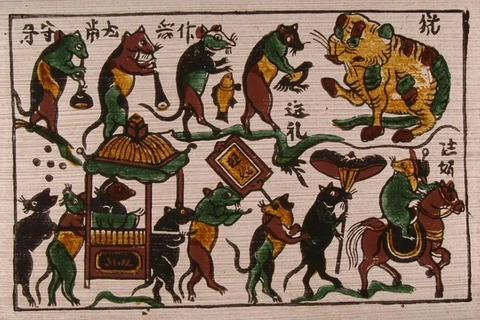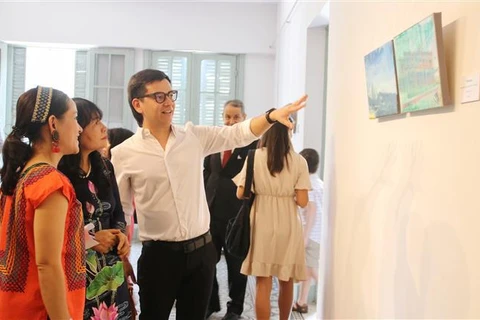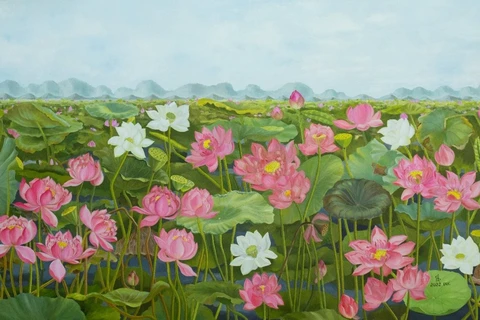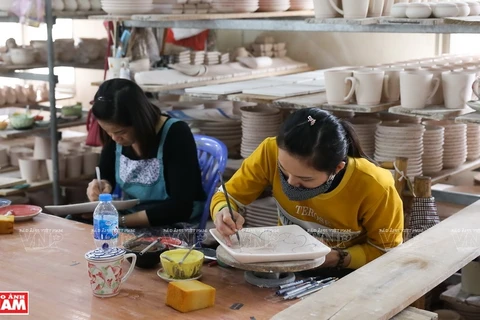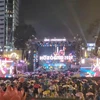Hanoi (VNA) – Young artists have exerted efforts to preserve the value of traditional Hang Trong paintings with materials other than the Vietnamese traditional art forms such as lacquer and silk.
Hang Trong folk paintings are usually known as décor for Lunar New Year (tet) festival or worshipping objects. Few people know that these paintings also depict the landscape and cultural practices of the public.
Visitors to the "Hang Trong folk paintings" exhibition held by the People's Committee of Hoan Kiem District on April 6 can enjoy works that reflect on the daily lives of farmers in the painting named “Rest” or a coner of society in the past in the painting “Western Festival”.
Those Hang Trong paintings were restored to the traditional standards by artisan Le Dinh Nghien. They are now in possession of collector Nguyen Quang Trung.
The exhibition also features 23 works by young artists inspired by Hang Trong folk paintings. These pieces were made from different materials and displayed in the installaton space created by painter Nguyen The Son.
The exhibition is a result of Son’s project "From Tradition to Tradition" where young artists attempt to dialogue and uphold the value of traditional paintings using various Vietnamese painting materials such as lacquer and silk.
A group of young artists who majored in lacquer and silk at the Faculty of Painting, the Vietnam University of Fine Arts, acquired the technique from renowned artisan Le Dinh Nghien through the initiative.
“The exhibition is an opportunity to introduce to the public the unique collection of Hang Trong paintings created by artisan Le Dinh Nghien as well as the new creations by young artists who are always interested in traditional heritage value,” said painter Son.
He said incorporating traditional culture into artistic practice is a smart way to protect and advance heritage values.
A member of the project, young artist Nguyen Thi Nhu Quynh said that after observing and researching, she found that Hang Trong paintings and lacquer ones have many similarities from colour transitions to calculating ratio. The meticulousness required when drawing, especially the details of Hang Trong's paintings, is very suitable for painting with lacquer.
Therefore, Quynh has taken advantage of the sharpness of the painting combined with the excellent material of lacquer to give Hang Trong paintings new colors, multi-tones and cheerful air, with the desire to bring a refreshing feeling to viewers.
Assessing the paintings, Dr. Tran Hau Yen The said that he was very impressed as the heritage element and the innovation factor go hand in hand at this exhibition.
“Young artists have developed the value of Hang Trong folk paintings on other traditional materials of the Vietnamese art such as silk and lacquer. At the same time, they have found other ways to express their works with big vases, recycled materials, and embroidery frames,” said The.
Hang Trong painting is one of the three typical folk paintings of Vietnam, named after Hang Trong Street, Hoan Kiem district, formerly in Tho Xuong district of Thang Long Capital (now Hanoi).
In Hang Trong folk paintings, painters use woodblock prints only to draw the major black contour lines that define the shapes. Hand coloring adds colors and tints that give the finished pieces more dimension.
The genre of Hang Trong paintings may have its last torchbearer in Master Le Dinh Nghien. He is now the only who knows the trade from A to Z. He teaches old art to his son Le Hoan and other young artists.
Using a unique approach, researcher Tran Hau Yen The believes that Hang Trong folk paintings will have a different life and be used in a wider range of settings, with higher applicability in interior decoration and architecture.
The exhibition lasts until April 16 at the Hanoi Old Quarter Cultural Exchange Center, 50 Dao Duy Tu Street, Hoan Kiem District.
The following are some of paintings at the exhibition:
 Nguu Lang-Chuc Nu [Nguu Lang, the herdsman of Jade Emperor, and Chuc Nu – clothing-making Goddess. They fall in love with each other and are allowed to meet once a year on the 7th lunar month. During their meeting, it usually rains heavily as the couple cry happy tears] by Le Dinh Nghien (Photo: VietnamPlus)
Nguu Lang-Chuc Nu [Nguu Lang, the herdsman of Jade Emperor, and Chuc Nu – clothing-making Goddess. They fall in love with each other and are allowed to meet once a year on the 7th lunar month. During their meeting, it usually rains heavily as the couple cry happy tears] by Le Dinh Nghien (Photo: VietnamPlus)  A lacquer vase embracing the image of Hang Trong painting by Nguyen Thi Nhu Quynh (Photo: VietnamPlus)
A lacquer vase embracing the image of Hang Trong painting by Nguyen Thi Nhu Quynh (Photo: VietnamPlus)  Ly Ngu Vong Nguyet (Carp Enjoys the Moon) by Truong Hoang and Nguyen Thi Hoai Giang (Photo: VietnamPlus)
Ly Ngu Vong Nguyet (Carp Enjoys the Moon) by Truong Hoang and Nguyen Thi Hoai Giang (Photo: VietnamPlus) 









